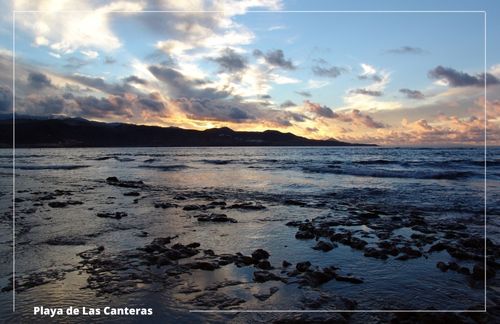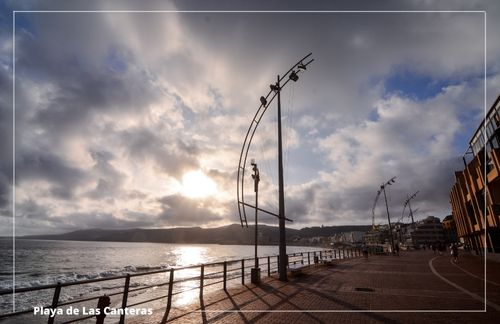Las Canteras Beach
Las Canteras Beach is known for being the main and most popular of the entire city of Las Palmas, and is even part of the most important of all the Canary Islands.
Location of Playa de Las Canteras
This beach begins right next to the isthmus of Guanarteme, and to the northeast you can see the mountains of the Isleta peninsula. It is considered to be the longest beach of all those found within the city.
It is oriented to the northeast right in the arch or also known as the Bay of Confital, and, in addition, it also extends from the foothills of La Isleta to almost reach the mouth of one of the best known ravines, the Tamaraceite.
The beach is safe from the cold currents of the Atlantic thanks to a natural bar, created of sandstone and reefs, this is popularly known as ''La Barra'.

On the inner side of the coast, is the Paseo de Las Canteras, it is one of the paths that you can visit without any problem and enjoy everything that the area that is popularly known as ''La Puntilla'' has to offer.
That beach was previously known only by surfers and bodyboarders, this because it produces the best known right wave in Europe.
Las Canteras beach is made up of important areas with arches and inflections that develop along the coast. And each of these has different morphological characteristics that you should know.
North Arc
It is popularly known as Playa de Las Canteras or Playa Grande, it is characterized by having an approximate extension of 1,120 meters, while the width is 20 m in relation to the southern area, the center 120 m and the north with 80 meters.
It is the area even, with more protection of the whole beach, and this because during most of the year it is naturally protected with the bar so you can enjoy a beautiful experience.

The main bar is the one that tourists mostly know. In addition, what characterizes it is that once you are submerged in its waters, you can see a variety of platypuses, and on the surface large seagulls.
La Puntilla is what is known as the end of the beach where it ends, in addition, it is characterized because it is the place where there is more sand.
That there is a greater amount of sand in this place, is due to all the natural dynamics of dragging that is generated in Las Canteras, and that is currently damaged.
Central Arch
It has a length of 76 meters, and width 80 m, one of the largest arches but is becoming narrower in its central area.
It is a very small arch that gives rise to Playa Chica, one of the best known areas of Las Canteras beach.
The latter place has a length of 120 m, and the width of 80 m to low tide level, and at the ends to 20m.
It is an arch that is characterized, in addition, because its shore is considered the most rocky and stony of the entire beach. It is perhaps because of this, there is a great loss of sand.
In addition, this arch is protected by another bar that is not the main one, and this is known as the yellow bar.

Just 60 m from the shore you can also find the best known rock of Las Canteras beach. La Peña de la Vieja is 15 meters in diameter.
In this area you can also find other rocks and also large rocks that you can observe, especially when the low tides develop.
In this arch it is important to mention that the space that is separating the yellow bar from the main one, is known as ''The passage''. It is known in this way, because all light boats can cross it without problems.
South Arc
It is the arch that makes up the entire beach of Cícer or Guanarteme, including also Punta de Núñez and Los Muellitos, both places located just behind the Alfredo Kraus Auditorium.

It extends over 1,080 meters in length and in width with 80 meters at low tide. This is one of the areas of the beach that is not protected by the well-known bar. For this reason, all its characteristics are often modified due to variations in waves.
The sand that can be seen in this arch is very fine, and a little denser than those of the rest of the beach.
How was Las Canteras Beach formed?
In the beginning this island was really an isolated islet, which was separated from the Island of Gran Canaria.
On the southeast side was generated the isthmus of Guanarteme, a tongue of land that turned it into a Peninsula.
The western slope of the isthmus is completely formed by the beach of Las Canteras, and the eastern one has all the facilities of Puerto de la Luz.
There were also different contributions of fresh water from the ravine of the Whale that ended up on the coast. These in turn helped the beach to be more compact, thus generating the large rock that can currently be seen.

Thanks to the changes of waves, and also to the time that has passed, the bar and the rocks have received great changes, until obtaining what is seen today.
This is how Las Canteras Beach originates, which was originally known as Arrecife Bay.
What is the history of Las Canteras Beach?
All the information of the beach was obtained in the fifteenth century, however, in the years 1410 and 1460 there were already some plans of the Isleta and it was separated from the island.
By 1479 a boat was considered necessary to move from that port to the city.
In the sixteenth century it is given the name of Puerto del Arrecife, and is also established as a place for embarkation and disembarkation.
In 1686, thanks to Pedro Agustín del Castillo, the first shot of the isthmus was made, where the Bay of the Reef was reflected. At first it was a little visited place, because the city was not as extensive as it is today.
In the nineteenth century begins the construction of all the works of the road that would be responsible for linking the beach with the port. After all this, the beach began to be more visited, and not only by the inhabitants of the city but also by tourists.
Flora and Fauna of Las Canteras Beach
The waters of this beach currently have approximately 210 species of algae, it is even the only place in the Canary Islands where you can see red algae.
You can also see other plants such as seba, it is one of the most important and therefore are protected by environmental legislation. You can even see green algae, and also brown algae in the company of red ones.
You find different species, such as bream, palometa, viejas, pejeverdes salemas, white fulas, black, cabosos, among others.
Crabs, brittles, limpet hermits, sea urchins, starfish, anemones, clams, shrimp, corals, among others.
